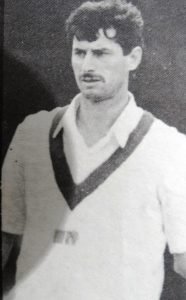Well, to be honest, it says a lot about how good and effective Richard Hadlee was. He bore a fair comparison as a fast bowler with Dennis Lillee and Michael Holding in the late 1970s. And the early ’80s, with Imran Khan and Malcolm Marshall in the mid-to-late ’80s. Richard Hadlee was not as fast as either but that did not greatly matter. What happened was that he had a much less impressive backup. He was actually, in essence, the New Zealand bowling attack for the majority of his career. Richard Hadlee was evidently better than anyone else on the team and he was the one who was going to get you out.

He was in extreme danger in overcast conditions. If he had a good day, his side was in the game; if he didn’t, they were not. It was not like that if you played Australia or West Indies. It is to Hadlee’s immense credit for how competitive New Zealand became.
They had some reliable batsmen and one batsman of near-genius in Martin Crowe, and they were well led for a long time by Geoff Howarth, but broadly speaking, it was Hadlee who delivered the victories.
When England was beaten for the first time in 48 years at Wellington in 1978, Hadlee cut them apart with figures of six for 26. When England was beaten in a series for the first time, in New Zealand in 1983–84, and then again in England in 1986 (series in which I was on the receiving end), he was the star bowler in the games his side won at Christchurch and Trent Bridge.
He was also central to events when New Zealand won their first series against the West Indies (1979–80), India (1980–81), and Australia (both home and away in 1985–86). The remarkable victories over Australia were particularly memorable as Australia paid a heavy price for preparing juicy surfaces at Brisbane and Perth and saw unplayable Hadlee make much better use of conditions than their own players.
Richard Hadlee first-innings figures at the Brisbane Gabba of 9 for 52 and match figures of 15 for 123 are incredible performances and the best-ever match figures for New Zealand in all Tests. Overall, in all six matches, Hadlee claimed a staggering 49 wickets at a marvelous average of 16.08. The Australians had no answer for him. Moreover, his great strength was hitting the right length and hitting the perfect seam.
Richard Hadlee gave away very little margin to the batsman. He generated an extremely dangerous curve through the air but the main challenge was that he was going to keep bowling a length, keep you coming forward, then bowl you a bouncer, which would be sharp in pace.
Hence, just to stop you from taking liberties or to change the rhythm a bit,. Batsman confesses he hit me on the head more than most, mostly when you weren’t wearing a helmet. which adequately demonstrates that he could be more than quick enough when it suited the conditions. In those days, at least against anyone but the West Indies, you might wear a helmet while playing yourself in, then take it off as you felt more comfortable.
I did this once against New Zealand in a Test at The Oval, and Hadlee clearly took exception to me strolling out after tea without headgear. He sent down a series of potent bouncers. Even one of them struck David Gower with a glancing blow on the head. He’d made his point. Although he moved the ball more through the seam than swung it, he could indeed swing it.
David Gower says that in a match at Christchurch in 1983–84, he found me severely embarrassed, deciding on seeing the ball leaving his hand that this was one to leave, only to realize when the ball was halfway down that it was now swinging in nicely. Bad decision. It was an lbw that a blind man could have given on the certainty of the appeal alone! He possessed a fine-flowing action. In his early cricketing career, before I really came across him, he came in on a very long run but his bowling was rather wild in those days and he took the decision to cut it down and concentrate on control.

